|
|
 |
Fiche d'espèce de Copépode |
|
|
Calanoida ( Ordre ) |
|
|
|
Diaptomoidea ( Superfamille ) |
|
|
|
Pseudodiaptomidae ( Famille ) |
|
|
|
Pseudodiaptomus ( Genre ) |
|
|
| |
Pseudodiaptomus binghami Sewell, 1912 (F,M) | |
| | | | | | | Syn.: | Schmackeria binghami : Marsh, 1933 (p.43, figs.F,M);
non Pseudodiaptomus binghami malayus Wellershaus, 1969 (p.262, figs.FM) | | | | Ref.: | | | Sewell, 1912 (figs.F, Descr.F); 1919 (p.7, Rem.F,M); 1924 (p.786, fig.M, Rem.); 1932 (p.240); 1948 (p.367); Silas, 1972 (p.648); Pillai, 1976 (1980) (p.251, figs.F,M); Pillai, 1976 (1980) (p.251, figs.F,M); Ranga Reddy & Radhakrishna, 1982 (p.256, Redescr.F,M, figs.F,M); Dussart & Defaye, 1983 (p.31); Sarkar & al., 1986 (p.178); Walter, 1986 (p.132); 1986 a (p.503); 1987 (p.367); Mitra & al., 1990 (fig.3); Walter, 1994 (p.126, figs.F,M); Ramaiah al., 1996 (p.3); Ferrari & Dahms, 2007 (p.22, Rem. N); Santu K.S. & al., 2017 (p.5, figs.F, M, Rem.: genetic analysis) |  Issued from : R.B.S. Sewell in Rec. Indian Mus., 1912, 7. [Pl.XVII, Figs.8-11]. Female (from Bay of Bengal): 8, habitus (lateral left side); 9, P2; 10, P5; 11, caudal ramus. Nota: - Head and 1st thoracic segment fused, 4th and 5th fused. - Posterior border of the thorax rounded and bears a small spine near the dorsal surface. - Rostrum small and bifid. - Abdomen 4-segmented; proportional lengths of urosomites and furca as 45 : 25 : 30 : 12 : 28; the 1st segment has 2 transverse rows of minute spines on its dorsal surface and a row of spines round the dorsal half of its posterior border; there is a small blunt projection on the ventral aspect, behind the genital opening. - Caudal rami symmetrical and bear 5 setae, of which the third is considerably wider than the others and is spear-shaped. - Terminal segment of the endopod of A2 with a row of sharp spines. - P5 symmetrical.
|
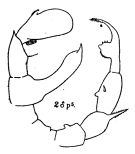 issued from : R.B.S. Sewell in Fauna of the Chilka Lake, 1924, 12. [Pl. XLV, Fig.2]. Male: P5
|
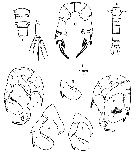 Issued from : T. C. Walter in Hydrobiologia, 1994, 292/293. [p.126, Fig.2]. Female (from Chilka Lake, India): A, urosomal somites 1-2 (dorsal); B, tip of left caudal ramus showing thickened setae; C, P5 (anterior view). Male: D, utosome (ventral); E, P5 (posterior view); F, P5 (anterior view); G, P5 of left exopodal segment 2 (posterior view); H-I, left basipod 2-exopod segment 2 variation.
|
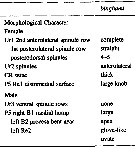 Issued from : T. C. Walter in Hydrobiologia, 1994, 292/293. [p.128, Table 2]. Morphological features of Pseudodiaptomus binghami from India and Bangladesh;
Compare with P. lobipes and P. mixtus.
|
 Issued from : T. C. Walter in Hydrobiologia, 1994, 292/293. [p.128, Table 1]. Pseudodiaptomus binghami from India: Sex, number of specimens measured, total body length range, mean total body length, mean prosome length, mean urosome length and prosome/urosome ratio of lengths. Compare with the two species in India and Bangladesh P. lobipes and mixtus.
|
 Issued from : Y. Ranga Reddy & Y. Radhakrishna in Hydrobiologia, 1982, 87. [p.258, Plate I]. Female (from 16°32'- 16°47'N; 81°4'-81°22'E): 1, habitus (dorsal with egg sacs (each with about 11 eggs); 2, same (lateral); 3, posterior part of prosome and urosome (dorsal); 4, genital area; 5, A1 and rostrum; 6, A2; 7, Md; 8, Mx1; 9, Mx2; 10 & 10a, Mxp and its modified seta; 11, P5. Nota: Proportional lengths prosome and urosome 64:36. - Head and 1st pedigerous segment fused, 4th and 5th pedigerous segments fused. - Rostrum consists of 2 filaments, short. - Posterolateral corners of prosome rounded with a dorsal spine. - Urosome 4-segmented plus caudal rami proportional lengths 31 : 15 : 21 : 9 : 22. - Genital segment symmetrical and has on the dorsal surface minute spines, arranged in 4 transverse rows; the 1st row interrupted in the middle with about 10 spines on either side; the 2nd row discontinuous laterally; the spines of these 2 rows smaller than those of the following rows; the 3rd row complete with about 8 relatively large spines on either side; the 4th row, like the first one, broken in the middle having about 6 somewhat large spines on either side. - Caudal rami symmetrical, divergent and slightly over 3 times as long as broad with hairy inner margins; each ramus with 5 unjointed setae, of which the middle one dilated and spear-shaped. In addition, a small sensory bristle lies between the 4th and 5th setae. - A1 21-segmented, reaching nearly up to the posterior margin of the genital segment. - A2 biramous, basipodite with 5 lateral setae, and 3 minute spines at its distal internal corner; exopodite ubsegmented with 7 terminal and 8 subterminal setae, and a row of minute spines along its distal internal border; endopodite 4-segmented with 1, 4, 3 and 4 setae respectively. - Md gnathal lobe chitinized with 9 or 10 teeth and a fine seta; basipodite large with 4 inner marginal setae; exopodite indistinctly 4-segmented with 1, 1, 1 and 3 setae respectively; endopodite 2-segmented with 4 and 8 setae. - Mx1 precoxa with 16 spiniform setae; coxal and basal endites with 4 setae each; basipodite with 5 setae; exopodite unsegmented with 9-10 setae; basal exite absent, coxal exite with 8 strong and 1 slender setae; endopodite 3-segmented with 4, 4 and 6 setae respectively. - Mx2 precoxa and coxa fused, each having 2 endites with 3 setae each; basis has 2 unequal endites, the proximal one larger with 3 setae while the distal smaller with 2 setae; endopodite vaguely 3-segmented with 1, 1 and 3 setae. - Mxp 6-segmented, the proximal 2 segments much larger than the distal ones. The 1st segment with 8 setae, in addition, it has a strong spine, sharply bent over the segment; the distal internal corner of the segment spinulose . - P5 both the left and right legs identical, uniramous and 4-segmented; basis slightly broader than coxa, with a ledge on the inner margin and a few spinules on the distal outer region.; exopodite 1 cylindrical and longer than the rest, having a strong internally serrated spine at the distal external angle, and a short blunt spinous process with a hyaline lobe at the distal internal angle; exopodite 2 bears 4 strong, serrated spines, of which 3 short and 1 longer than the combined length of basis and exopodite 1.
|
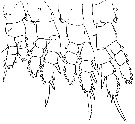 Issued from : Y. Ranga Reddy & Y. Radhakrishna in Hydrobiologia, 1982, 87. [p.259, Plate II, 12-15]. Female: 12, P1; 13, P2; 14, P3; 15, P4.
|
 Issued from : Y. Ranga Reddy & Y. Radhakrishna in Hydrobiologia, 1982, 87. [p.257]. Female: The length-width proportions of the caudal ramus and setae (counted from outside).
|
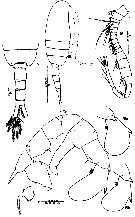 Issued from : Y. Ranga Reddy & Y. Radhakrishna in Hydrobiologia, 1982, 87. [p.259, Plate II, 16-19b]. Male: 16, habitus (lateral); 17, posterior part of prosome and urosome (dorsal); 18, Right A1; 19, P5 (anterior view); 19a & 19b, exopodite 2 of left P5. Nota: Left A1 as in the female except for the aesthetasc on segment 3 stalked and comparatively longer, extending up to 9th segment. Right A1 modified, consisting of 21 segments; geniculation lies between segments 18 and 19; segments 8-12 narrow, segments 13-17 moderately dilated; a hooked spine on the segment 10, an unarmed tooth-plate on segment 17, fine needle-like spines along the margin of segment 18, and fine, slightly curved teeth along the proximal part of segment 19, segments 20 and 21 fused and ending in a knoblike process with 5 setae and 1 aesthetasc. - Urosome of 5 segments plus caudal rami have the proportional lengths 10.5 : 20.0 : 16.0 : 18.5 : 8.0 : 22.0. 1st urosomal segment somewhat broad midway, with a minute spine on either side. - The dorso-posterior border of the 2nd, 3rd and 4th segments with a transverse row of fine spines. - Caudal rami and setae as in the female, the only difference being that the middle caudal seta quite normal ; all the setae jointed and slenderer than in female.
|
 Issued from : K.S. Santu, S. Bijoy Nandan, R.I. Cleetus & M. Harikrishnan in Mitochondrial DNA Part A, 2017. [p.6, Figs. 9, 10]. Female;: fig.9, habitus (lateral view); fig.10, urosome (lateral view). Nota: - Prosome : Urosome ratio 60 : 40. - Prosome 1.29 times longer than broad (9.5 : 1.6). - Urosome 4-segmented with caudal rami. Proportional lengths of urosomal segments plus caudal rami - 33 : 16 : 19 : 11 : 21 = 100.. - Genital segment symmetrical; provided with pair of outwardly projecting sutures and 4 transversaly arranged rows of minute spines on dorsal surface. - Caudal rami 3.14 times long as wide with hairy inner margins; each ramus bearing 5 unsegmented setae, of which muddle one dilated aznd spear-head-shaped; small sensory bristhe lying between 4th and 5th setae - A1 21-segmented, reaching to posterior margin of genital segment.
|
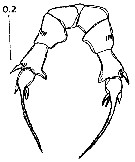 Issued from : K.S. Santu, S. Bijoy Nandan, R.I. Cleetus & M. Harikrishnan in Mitochondrial DNA Part A, 2017. [p.6, Fig. 11. Female: P5 (dorsal view). Scale bar in mm. Nota: - P5 consisting of coxa basis,, exopodal segments 1 and 2; left and right legs identical and uniramous; basis with ledge on inner margin and furnished with few spinules on distal outer region; exopodal segment 1 with strong internally serrate spine at distal external angle and short, blunt spinous process with hyaline lobe at distal internal angle; distal external margins furnished with small row of spinules just behind above mentioned serrate spine; exopodal segment 2 with 4 strong serrate spines, one of which longer than other 3 short ones
|
 Issued from : K.S. Santu, S. Bijoy Nandan, R.I. Cleetus & M. Harikrishnan in Mitochondrial DNA Part A, 2017. [p.7, Figs. 12, 13]. Male: fig.12, habitus (dorsal view); fig.13, urosome (dorsal view). Nota: - Prosome : Urosome ratio 59 : 41. - Urosome 5-segmented plus caudal rami; length proportions 16 : 18 : 18 : 18 : 10 : 20 = 100. - Caudal rami and caudal setae as in female except that middle setae normal; all setae joined and more slender than in female.
|
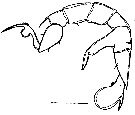 Issued from : K.S. Santu, S. Bijoy Nandan, R.I. Cleetus & M. Harikrishnan in Mitochondrial DNA Part A, 2017. [p.7, Fig.14]. Male: P5 (ventral view). Scale bar in mm. Nota: - P5 as described by Ranga Reddy & Radhakrishna (1982).
|
 Issued from : K.S. Santu, S. Bijoy Nandan, R.I. Cleetus & M. Harikrishnan in Mitochondrial DNA Part A, 2017. [p.8, Table 3]. Morphological characteristics of female specimen of P. malayalus with previous record of P. malayalus and P. binghami. (specimen from Nambur canal, Andhra Pradesh, India).
| | | | | Ref. compl.: | | | Madhupratap & Haridas, 1986 (p.105, tab.2) | | | | NZ: | 1 | | |
|
Carte de distribution de Pseudodiaptomus binghami par zones géographiques
|
| | | | | | | Loc: | | | India, Cochin (Vembanad estuarine system), Burhabalanga estuary, Chilka Lake, Nagarjuna University Reservoir, W Bengal (Mandarmani creek, Hooghly estuary), Rangoon Riv. (estuary), Andaman Is. | | | | N: | 12 | | | | Lg.: | | | (81) F: 1,3; (83) M: 0,86; (1005) M: 0,91; (1190) F: 0,97-1,28; M: 0,82-0,95; (1193) F: 1,09-1,18; M: 0,85-0,91; (1211) F: 1,23-1,29; M: 0,86-0,90; {F: 0,97-1,3; M: 0,82-0,95} | | | | Rem.: | saumâtre, limnique, estuaire.
Incomplete data.
Voir aussi les remarques en anglais | | | Dernière mise à jour : 18/12/2017 | |
|
|
 Toute utilisation de ce site pour une publication sera mentionnée avec la référence suivante : Toute utilisation de ce site pour une publication sera mentionnée avec la référence suivante :
Razouls C., Desreumaux N., Kouwenberg J. et de Bovée F., 2005-2026. - Biodiversité des Copépodes planctoniques marins (morphologie, répartition géographique et données biologiques). Sorbonne Université, CNRS. Disponible sur http://copepodes.obs-banyuls.fr [Accédé le 07 janvier 2026] © copyright 2005-2026 Sorbonne Université, CNRS
|
|
 |
 |














